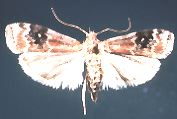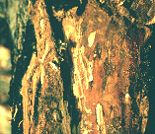
II. Hosts: The APB is a cambium feeder on a wide range of deciduous trees and bushes but prefers members of the rose and walnut families and is a known pest of many commercially grown nut and fruit trees. Of the tree fruits, it prefers tart cherry, plum, and sweet cherry, but is an occasional pest of pear, peach, nectarine and apple. Heavy infections of black knot growth in plum orchards are extremely attractive feeding sites for the larvae. On apple it can sometimes cause serious damage by feeding in burr knots in much the same way as the dogwood borer. The APB is also a minor pest of almonds, pecans, walnuts, and olives as well as several species of ornamental trees such as mountain ash and London plane tree. It can also be found as a pest of stored sweet potato tubers.
III. Description: Adults (see photo above) are about 1 inch (25 mm) long and have a wingspan of 4/5 inch (20 mm). Their forewings vary in color from a reddish brown to a grayish brown background with a broad, wavy vertical band of black and brown markings across the outer third of the wing. The hind wings are a light dusky tan with the veins somewhat darker in color. The female is slightly larger than the male and may lay between 20-50 eggs during a relatively short 3-4 day oviposition period. Females are strongly attracted to fresh wounds in the bark such as from mechanical harvesters or from pruning, laying their eggs singly or in small clumps nearby on the rough bark. The eggs are a bright, reddish, pink color when first laid but turn white with age and hatch in 7-10 days.
The newly hatched larvae immediately enter the nearby wound to feed on the underlying cambium. The larvae pass through 7 instars with the final instar reaching a length of almost an inch (25 mm) (left photo below). The larvae vary in color from a more common dusky greenish white to a reddish purple color. The head capsule and thoracic shield are a darker brown color than those of the very similar, but pure white LPTB larvae. The crochets of the larval prolegs of the APB are arranged in circular pattern rather than in a semicircle like the LPTB. Pupae are about 1/2 inch (13 mm) long and are found in a white silken cocoon under the bark with reddish frass scattered around, but not a part of the cocoon. Pupa of the LPTB are similar in size, but the cocoons are a dark brown color with the frass forming an integral part of it.


IV. Biology: The APB overwinters as a nearly full grown sixth or seventh instar larva within a silken hibernaculum. The hibernacula are formed near the feeding sites on the underside of the overlying dead bark. The larvae become active in the spring as soon as cherry buds begin to open. Most larvae pupate within their overwintering hibernacula without additional feeding. First adult emergence generally occurs about two weeks later by the white bud stage and peak adult emergence occurs just after full bloom. The majority of the eggs are laid by petal fall, although adult emergence often continues for another three weeks. The first summer brood larvae emerge to feed on cambium and complete development by late May to early July. Adult emergence of the second brood generally begins by late May and peaks during tart cherry harvest in mid July. Adult emergence of this brood is often very long with many adults being caught in August and a few even to the end of September. This brood is the most devastating since emergence coincides with mechanical harvesting of cherries. At this time, there is an abundance of fresh cracks and wounds in the bark that open to the cambium for female oviposition. Second brood eggs hatch during cherry harvest when chemical control is difficult because of residue problems on the harvested fruit. In Michigan, several ichneumonid parasitoids and a fungal pathogen, Hirsutella sp., were found to contribute up to 25% control of APB larvae even in commercial orchards during the season.
V. Injury: In cherry, the APB larvae feed exclusively on the cambium with sweet cherry being slightly more tolerant of damage than tart cherry. About 90% of the larvae are found girdling the trunk and lower scaffold limbs (right photo above) within 4 feet (1.2 m) of the ground where the clamps from the trunk shakers have caused wounds for entry. Limb shakers, however, may cause infestations above this height as will heavy top pruning. Tart cherry orchards averaging over ten larvae per tree are common in some cherry growing regions of Michigan, but the APB does not seem to be as serious a pest further south. Populations of this size are capable of girdling 6 inch (15 cm) scaffold limbs within 3-5 years and girdle an 18 inch (46 cm) trunk in 10 years. The decrease in the life of the orchard from this kind of population in Michigan has been estimated at 25% due to the entry of disease into these wounds and death from the eventually complete girdling of a trunk or limb. In plums, the larvae may also feed on black knot growth on the limbs. In apples, the APB may be found feeding in burr knots along with the dogwood borer, especially when NAA (naphthalene acetic acid) has been used to kill the burr knots.
VI. Monitoring: Timing of sprays can be predicted by trapping adults using a commercially available sex pheromone to monitor male flight. The number of males can not always be used to predict population size in the orchard since the males are capable of flying long distances, and adjacent woodlots may contain many alternate hosts of APB, and significant native populations. Monitoring traps should therefore be placed away from the edges of the orchards and more in the center of the orchard when possible. A more accurate way to measure damage is to check for the white hibernacula and reddish frass around shaker wounds by peeling away any overlying dead bark near the wound just before white bud or before harvest when new hibernacula can be distinguished from those of previous years by the presence of live pupae. These sample trees should be scattered throughout the block. Examination of the wounds on these trees often requires the use of a long handled screwdriver or wood chisel to pry away the dead bark around the wound to see the underlying larvae and hibernacula.
In Michigan, if the average catch of three traps
in a 10 acre (4 hectare) cherry block exceeds six moths per trap/ week
during the adult flight of either generation, the APB is probably
causing
economic damage. If additional monitoring of several trees visibly
wounded
from previous years show more than 2-3 live larvae or fresh hibernacula
per tree, a dilute handgun application of a long residual insecticide
to
the trunk and lower scaffold limbs is recommended during the peak egg
laying
of the first brood (generally at petal fall). Pesticide applications
for
the summer brood are generally not possible because of restrictions
during
harvest, and investigations in Michigan have shown that a single
application
of some long residual insecticides will give season long control of
both
broods if applied at the correct time for the first brood.